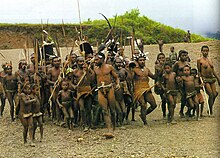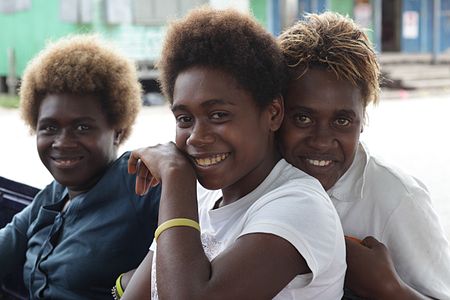Indigenous people of New Guinea


The indigenous peoples of New Guinea, commonly called Papuans,[1] are Melanesians. There is genetic evidence for two major historical lineages in New Guinea and neighboring islands:
- a first wave from the Malay Archipelago perhaps 50,000 years ago when New Guinea and Australia were a single landmass called Sahul,
- and, much later, a wave of Austronesian people from the north who introduced Austronesian languages and pigs about 3,500 years ago, and who left a small but significant genetic trace in many coastal Papuan peoples (only a minority of Austronesian-speaking Papuans have detectable Austronesian ancestry).
Linguistically, Papuans speak languages from the many families of non-Austronesian languages that are found only on New Guinea and neighboring islands, as well as Austronesian languages along parts of the coast, and recently developed creoles such as Tok Pisin, Unserdeutsch, and Papuan Malay.[2][3][4]
The term "Papuan" is used in a wider sense in linguistics and anthropology. In linguistics, "Papuan languages" is a cover term for the diverse, mutually unrelated, non-Austronesian language families spoken in Melanesia, the Torres Strait Islands, and parts of Wallacea. In anthropology, "Papuan" is often used to denote the highly diverse aboriginal populations of Melanesia and Wallacea prior to the arrival of Austronesian-speakers, and the dominant genetic traces of these populations in the current ethnic groups of these areas.[3]
Languages[]

Ethnologue's 14th edition lists 826 languages of Papua New Guinea and 257 languages of Western New Guinea, a total of 1073 languages, with 12 languages overlapping. They can be divided into two groups, the Austronesian languages, and all the others, called Papuan languages for convenience. The term Papuan languages refers to an areal grouping, rather than a linguistic one. So-called Papuan languages comprise hundreds of different languages, most of which are not related.[5]
Genetics[]
In a 2005 study of ASPM gene variants, Mekel-Bobrov et al. found that the Papuan people have among the highest rate of the newly evolved ASPM Haplogroup D, at 59.4% occurrence of the approximately 6,000-year-old allele.[6] While it is not yet known exactly what selective advantage is provided by this gene variant, the haplogroup D allele is thought to be positively selected in populations and to confer some substantial advantage that has caused its frequency to rapidly increase.
Main Y-DNA Haplogroups of Papuan people are Haplogroup K2b1 (Y-DNA) and Haplogroup C1b2a; a significant minority belong also to Haplogroup O-M175.[7]
Papuan ethnic groups[]
This section needs expansion. You can help by . (April 2019) |
The following indigenous peoples live within the modern borders of Indonesia and Papua New Guinea. Austronesian-speaking (AN) groups are given in italics.
Indonesian West Papua[]
Here are Papuan ethnic groups / tribes in Indonesian province of West Papua:[8]
- Abun
- Ambel
- Arfak
- Awe
- Ayamaru
- Ayfat
- Aytino
- Batanta
- Biga
- Bira
- Borai
- Butlih
- Domu
- Doreri
- Emeyode
- Fiawat
- Hatam
- Irarutu
- Irires
- Iwaro
- Kais
- Kawe
- Koiwai
- Kuri
- Langanyan
- Madekwana
- Mairasi
- Maniwak
- Matbat
- Mbaham
- Matta
- Meiah
- Meybrat
- Miere
- Miyah
- Moi
- Moire
- Moru
- Moskona
- Mpur
- Napiti
- Nerigo
- Oburauw
- Roon
- Roswar
- Sebyar Kemberan
- Sebyar Damban
- Sougb
- Soviar
- Sumuri
- Tehit
- Tepin
- Wamesa
- Warumba
- Waruri
- Wawiyai
- Wondama
- Yaban Nerigo
- Yaben
Indonesian Papua[]
Here are Papuan ethnic groups / tribes in Indonesian province of Papua.[9]
Ethnic groups based around Jayapura City:
- Kayu Batu/ Kayu Pulau
- Tobati/Enggros
- Nafri
- Skouw
- Sentani
Ethnic groups based in Jayapura Regency:
- Demta
- Kaureh
- Kemtuk
- Kawamsu
- Mekwei
- Narau
- Gresi
- Nimboran
- Oria
- Ormu
- Kapori
- Foya
- Sauso
- Tabia
- Tarpia
- Taworfa
- Yansu
- Yamna
- Kendate
- Tofamna
- Bauwi
Ethnic groups based in Sarmi Regency:
- Akwaikai
- Airoran
- Anus
- Baburiwa
- Bagusa
- Yarsun
- Bapu
- Bonerif
- Lairawa
- Kauweraweo
- Mander
- Papasena
- Wakde
- Baso
- Bonggo
- Itik
- Keder
- Maremgi
- Podena
- Marembori
- Babe
- Kabera
- Kwerba
- Masimasi
- Samarokena
- Wares
- Berik
- Dabra
- Kwesten
- Massep
- Sobei
- Warotai
- Betaf
- Foau
- Kapitiauw
- Liki
- Nopuk
Ethnic groups based in Keeron Regency:
- Aywi
- Janggu
- Taikat
- Yafi
- Manem
- Sowei
- Dubu
- Molof
- Usku
- Emumu
- Sangke
- Waina
- Senggi
- Waris
Ethnic groups based in Biak Numfor Regency:
- Borapasi
- Bonefa
- Kofei
- Sauri
- Siromi
- Tafaro
- Waropen
- Wairata
- Burate
- Sedasi
- Otodema
- Demisa
- Demba
- Biak
Ethnic groups based in Waropen Regency:
- Amabi
- Ansus
- Busami
- Karema
- Kurudu
- Marau
- Munggui
- Nisa
- Papuma
- Pom
- Arui
- Woi
- Anate
- Nakabui
Ethnic groups based in Yapen Regency:
- Borapasi
- Bonefa
- Kofei
- Sauri
- Siromi
- Tafaro
- Waropen
- Wairata
- Burate
- Sedasi
- Otodema
- Demisa
- Demba
Ethnic groups based in Mamberano Regency:
- Bauzi
- Duvle
- Tauraf
Ethnic groups based in Mimika Regency:
- Komoro
- Sempan
- Damal
- Amung
Ethnic groups based in Jayawijaya Regency:
- Nduga
- Walak
- Hugula
Ethnic groups based in Yahukimo Regency:
- Hmanggona
- Hupla
- Inlom
- Korupun
- Sela
- Mek Kosarek
- Momuna
- Mek Nipsan
- Ngalik
- Lani Lembah
- Mek Nalca
Ethnic groups based in Tolikara Regency:
- Eiponek
- Taori
- Kwerisa
- Toarikei
- Turui
Ethnic groups based in Pegunungan Bintang Regency:
- Yali
- Ngalum
- Biksi
- Ketangban
- Tyu
- Sukubatong
- Una
Ethnic groups based in Painai Regency:
- Mee (Ekari)
- Dou
- Wodam
- Wolani
Ethnic groups based in Puncak Jaya Regency:
- Lani Barat
- Dem
- Fayu
- Kiri-kiri
- Moni
- Tause
- Wano
- Dani
Ethnic groups based in Nabire Regency:
- Iresim
- Mor
- Tunggare
- Yaur
Ethnic groups based in Merauke Regency:
- Bian Marind
- Kanum
- Kimaghama
- Maklew
- Marind Dek (Hulu)
- Marind Laut (Muara)
- Mombum
- Maraori
- Yey / Yei
- Sota
Ethnic groups based in Asmat Regency:
- Asmat
- Citak
- Pisa
- Sawi
- Tamnim
- Warkai
- Biplim
Ethnic groups based in Mappi Regency:
- Airo
- Awyu
- Kayagar
- Siagha
- Tamagario
- Yaghay
- Yaninu
- Sumaghaghe
Ethnic groups based in Boven Digoel Regency:
- Aghul
- Iwur
- Katik
- Kauwoi
- Kombai
- Korowai
- Kotogut
- Yanggon
- Okparimen
- Ninggerum
- Wambon
- Wanggom
- Yair
Papua New Guinea[]
- Abelam
- Angu
- Baruya
- Biangai
- Bilibil
- Chambri
- Duna
- Etoro
- Fore
- Gadsup
- Gogodala
- Haroli
- Hewa
- Huli
- Iatmul
- Kaluli
- Kwoma
- Koteka
- Maisin (AN with many non-AN elements)
- Melpa
- Mian
- Morkai
- Motu
- Min
- Mundugumor
- Ogea
- Orokaiva
- Sambia
- Swagap
- Tairora
- Tanga
- Telefol
- Tsembaga
- Urapmin
- Wiru
- Wola
- Wopkaimin
- Yaifo
- Zia
Bismarck Archipelago[]
- Baining
- Tolai
- Trobriand

Girls from Papua New Guinea

Papuan people in folk costume in Jakarta
Notable people[]
- Abba Bina, notable businessman
- Frans Kaisiepo, 4th Governor of Papua and National Hero of Indonesia
- Nitya Krishinda Maheswari, Indonesian badminton player and 2014 Asian Games women's doubles gold medalist
- Nowela Auparay, professional singer and the winner of Indonesian Idol
- Peter O'Neill, 7th Prime Minister of Papua New Guinea
- Freddy Numberi, politician and former Indonesian minister
- Raema Lisa Rumbewas, Indonesian weightlifter and silver medalist at 2000 Summer Olympics and 2004 Summer Olympics
- Boaz Solossa, Indonesian professional footballer
- Ricky Kambuaya
- Michael Somare, former Prime Minister of Papua New Guinea
- Heather Watson, English female tennis player
See also[]
- Aboriginal Australians
- Indigenous Australians
- Koteka Tribal Assembly
- List of ethnic groups of West Papua
- Moluccans (to the west of New Guinea)
- Negrito (Southeast Asia)
- Papua conflict
- Proto-Australoid
- Stéphane Breton (filmmaker)
- Torres Strait Islanders between New Guinea and mainland Australia (including the Meriam people, whose language family is otherwise found in New Guinea).
References[]
- ^ From the Malay word pəpuah 'curly hair'. "Papuan". Oxford English Dictionary (Online ed.). Oxford University Press. (Subscription or participating institution membership required.)
- ^ Encyclopædia Britannica Online
- ^ Jump up to: a b Friedlaender, Jonathan; Friedlaender, FR; Reed FA; Kidd KK; Kidd JR (2008). "The Genetic Structure of Pacific Islanders". PLOS Genetics. 4 (3): e19. doi:10.1371/journal.pgen.0040019. PMC 2211537. PMID 18208337.
- ^ Jinam, Timothy A.; Phipps, Maude E.; Aghakhanian, Farhang; Majumder, Partha P.; Datar, Francisco; Stoneking, Mark; Sawai, Hiromi; Nishida, Nao; Tokunaga, Katsushi; Kawamura, Shoji; Omoto, Keiichi; Saitou, Naruya (August 2017). "Discerning the Origins of the Negritos, First Sundaland People: Deep Divergence and Archaic Admixture". Genome Biology and Evolution. 9 (8): 2013–2022. doi:10.1093/gbe/evx118. PMC 5597900. PMID 28854687.
- ^ Palmer, Bill (2018). The Languages and Linguistics of the New Guinea Area. Mouton De Gruyter. ISBN 978-3-11-028642-7.
- ^ "Ongoing Adaptive Evolution of ASPM, a Brain Size Determinant in Homo sapiens", Science, 9 September 2005: Vol. 309. no. 5741, pp. 1720–1722.
- ^ 崎谷満『DNA・考古・言語の学際研究が示す新・日本列島史』(勉誠出版 2009年)(in Japanese)
- ^ Ronsumbre, Adolof (2020). Ensiklopedia Suku Bangsa di Provinsi Papua Barat. Yogyakarta: Penerbit Kepel Press. ISBN 978-602-356-318-0.
- ^ "Pemerintah Provinsi Papua". www.papua.go.id. Retrieved 2021-02-16.
Further reading[]
- W. G. Lawes (1882), "New Guinea and Its People", Popular Science Monthly
External links[]
 Media related to People of Papua at Wikimedia Commons
Media related to People of Papua at Wikimedia Commons
- Papuan people

